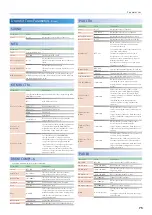
64
Parameter List
Parameter
Value
Explanation
Key Range Fade Up
0–127
Specifies the degree to which the partial
is sounded by notes played above the Key
Range Up. Specify “0” if you don’t want such
notes to be sounded.
Range Lower
Range Upper
Fade Lower
Fade Upper
Level
Velocity
Parameter
Value
Explanation
Velocity Range Low
1–127
Specify the lower limit (Lower) and upper
limit (Upper) of the velocities that will sound
the partial.
Make these settings when you want different
partials to sound depending on keyboard
playing dynamics.
Velocity Range Up
1–127
Velocity Fade Low
0–127
Specifies the degree to which the partial is
sounded by notes played more softly than
Velocity Range Low. Specify “0” if you don’t
want such notes to be sounded.
Velocity Fade Up
0–127
Specifies the degree to which the partial is
sounded by notes played more strongly than
Velocity Range Up. Specify “0” if you don’t
want such notes to be sounded.
TUNING
Parameter
Value
Explanation
Type
(Scale Tune Type)
CUSTOM
Custom:
This lets you create a custom scale.
EQUAL
Equal Temperament:
This tuning divides an octave into 12 equal
parts. Every interval produces about the same
amount of slight dissonance.
JUST-MAJ
Just (Major):
This scale eliminates dissonance in fifths
and thirds. It is unsuited to playing melodies
and cannot be transposed, but is capable of
beautiful sonorities.
JUST-MIN
Just (Minor):
The scales of the major and minor just
intonations are different. You can get the
same effect with the minor scale as with the
major scale.
PYTHAGORE
Pythagorean:
This scale, devised by the philosopher
Pythagoras, eliminates dissonance in fourths
and fifths. Dissonance is produced in thirds,
but melodies are euphonious.
KIRNBERGE
Kirnberger:
This scale is a modification of the meantone
and just intonations that permits greater
freedom in transposition to other keys.
Performances are possible in all keys (III).
MEANTONE
Meantone:
This scale makes some compromises in just
intonation, enabling transposition to other
keys.
WERCKMEIS
Werckmeister:
This is a combination of the meantone
and Pythagorean scales. Performances are
possible in all keys (first technique, III).
ARABIC
Arabic Scale:
This scale is suitable for Arabic music.
Key
(Scale Tune Key)
C–B
Sets the keynote.
C–B
-64–+63
Finely adjusts the pitch.
Part Parameter
(KNOB CTRL)
Parameters with the
“
ASSIGN
”
showing can be assigned to the knob.
Parameter
Value
Explanation
Level
ASSIGN
0–127
Adjusts the volume of each part.
Pan
ASSIGN
L64–0–63R
Specifies the panning of each part’s sound
when using stereo output.
Delay Send
(Delay Send Level)
ASSIGN
0–127
Specifies the send level to delay.
Rev Send
(Reverb Send Level) ASSIGN
0–127
Specifies the send level to reverb.
Coarse Tune
ASSIGN
-48–+48
Shifts the pitch in units of a semitone.
Fine Tune
ASSIGN
-50–+50
Finely adjusts the pitch in units of one cent.
Mono/Poly
MONO, POLY, TONE
Choose MONO if you want the tone assigned
to the part to play monophonically; choose
POLY if you want to play it polyphonically.
Choose TONE if you want to use the setting
specified by the tone.
Legato Sw
(Legato Switch)
OFF, ON, TONE
If you play monophonically, you can apply
legato. “Legato” is a performance technique
that smoothly connects one note to the next.
This produces an effect similar to hammering-
on or pulling-off when playing a guitar.
Choose “ON” to apply legato, or “OFF” if you
don’t want to apply it.
Choose “TONE” if you want to use the setting
specified by the tone.
Bend Range
0–24, TONE
Specifies the amount of pitch change in
semitone units (maximum two octaves) that
occurs when you move a controller when
pitch bend is assigned to that controller.
Choose TONE if you want to use the setting
specified by the tone.
Porta Sw
(Portamento Switch) ASSIGN
OFF, ON, TONE
Specifies whether portamento is applied.
Select ON to apply portamento, or OFF if you
don’t want to apply portamento.
Choose TONE if you want to use the setting
specified by the tone.
Porta Time
(Portamento Time) ASSIGN
0–127, TONE
When portamento is used, this specifies the
time over which the pitch will change. Higher
settings will cause the pitch change to the
next note to take more time.
Choose TONE if you want to use the setting
specified by the tone.
Cutoff
(Cutoff Offset)
ASSIGN
-64–+63
Adjusts how far the filter is open.
Increasing this value makes the sound
brighter, and decreasing it makes the sound
darker.
Resonance
(Resonance Offset)
ASSIGN
-64–+63
Emphasizes the portion of the sound in
the region of the cutoff frequency, adding
character to the sound. Excessively high
settings can produce oscillation, causing the
sound to distort.
Increasing this value strengthens the
character, and decreasing it weakens the
character.
Attack
(Attack
Time Offset)
ASSIGN
-64–+63
Adjusts the time over which the sound
reaches its maximum volume after you press
the key.
Larger settings of this value make the attack
gentler, and smaller settings make the attack
sharper.
Decay
(Decay Time Offset)
ASSIGN
-64–+63
Adjusts the time over which the volume
decreases from its maximum value.
Larger settings of this value make the decay
longer, and smaller settings make the decay
shorter.
Release
(Release Time
Offset)
ASSIGN
-64–+63
Adjusts the time over which the sound
decays to silence after you release the key.
Larger settings of this value make the sound
linger, and smaller settings make the sound
end more sharply.






























